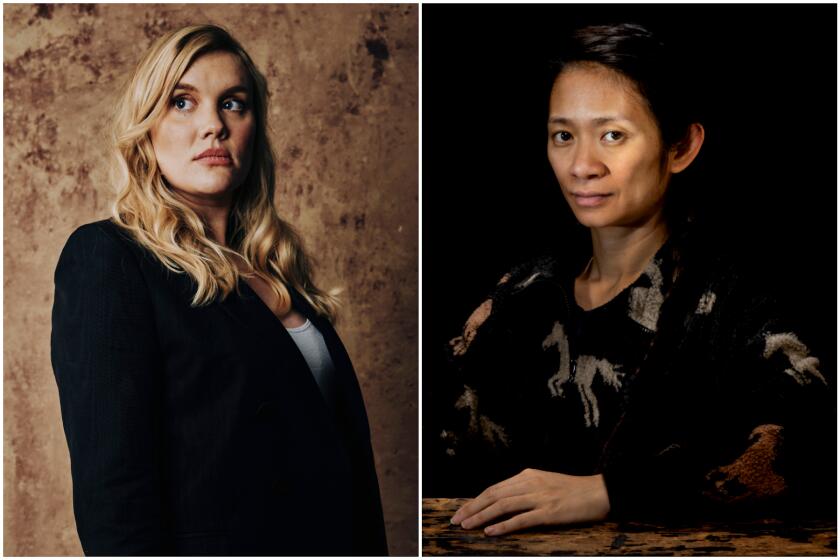Op-Ed: How Hollywood and the Oscar-nominated ‘Mank’ have written women out of the picture
- Share via
For most of a century, women have been written out of the history of Hollywood. That likely won’t change at Sunday night’s Academy Awards. “Mank” and its 10 Oscar nominations — the most of any film — will make sure of that.
With “Mank” as the measure, the mythmaking about Hollywood’s origins appears to be staying the course as a story written and directed by men. Hailed by critics as a “hard-hitting” look at the studio system’s golden age, the film about screenwriter Herman Mankiewicz’s legendary role in writing “Citizen Kane” creaks under the weight of its historically inaccurate cliches.
“Mank’s” early Hollywood is strictly an old boys club. Here men with outsized talent, ambition and ego battle over the industry’s political and artistic future. Marion Davies — the platinum-blond actress and long-term consort of media tycoon William Randolph Hearst, the inspiration for “Citizen Kane” — appears to be the only woman with actual work to do in the movies.
And in casting Gary Oldman as Mankiewicz and the decades-younger Amanda Seyfried as Davies, the film reproduces a stock situation first made famous in the 1930s by men such as Mank in which a young blond, smarter than she looks, watches while much-older men call the shots. In real life, Mankiewicz and Davies were born the same year.
Yet the story of how the decentralized business of making pictures in America became a glamorous oligarchy in Los Angeles — where at least 80% of the world’s movies were being churned out — is more of a tale of female ambition rewarded and then thwarted. By the time of “A Star is Born,” (1937), “Citizen Kane” (1941) and “Sunset Boulevard” (1950), women in the industry had become figures to be feared, punished or tucked away. By “The Last Tycoon” (1976), “The Artist” (2011) and “Mank,” women’s grand contributions had been erased.
A century ago, women wrote, directed, produced, edited, publicized and reported on commercial films in numbers that are, in many cases, unequaled today, according to a Columbia University database on women film pioneers. At Universal Pictures alone, women directed 12% of feature films in the 1910s. Almost a century later, the industry paid women to direct, at most, 9% of days of film production.
In early Hollywood, director Lois Weber was regarded as one of “three great minds” — along with D.W. Griffith and Cecil B. DeMille — who closely collaborated with the writer Jeannie Macpherson. Working-class actresses such as Mary Pickford and Gloria Swanson famously earned fabulous sums.
But dozens of other actresses joined them as star-producers. Pickford’s United Artists would be the most enduring example of what Photoplay called an “epidemic” of female-owned movie companies in 1917. Women began more than 30 production companies between 1910 and 1928, the years in which Hollywood grew to represent an industry, a place and an approach to life that reflected the period’s broader reimagining of gender roles.
Every historic ‘first’ reminds us of the long history of ‘none’ — it’s the first time in 92 years that two women have been nominated for directing.
Women also wrote most of the news stories about the movie colony as reporting on Hollywood soared in newspapers and fan magazines. Columnist Louella Parsons declared in 1921 that newspaperman Horace Greeley had once believed “the only interest the fair sex” could have in going West would be to “go as a helpmate to a man,” but “in the present day, if milady goes west … she goeth to make her fortune.”
This widely publicized vision of Hollywood’s version of the good life helped make Los Angeles the first Western American boomtown in which single women outnumbered men by 1920. Some observers estimated 75% of moviegoers were women. Iris Barry, a film critic who later became curator of the first film department at New York’s Museum of Modern Art, wrote in 1926 that the cinema exists “for the purpose of pleasing women.” She warned the industry to never lose sight of that fact.
The writers rooms that Mankiewicz joined were teeming with women when he arrived in Hollywood in 1926. At the time, Hollywood was the nation’s least sex-segregated capitalist industry, but racial stratification was endemic. Women headed the first scenario departments and helped pioneer the craft of screenwriting, writing 50% of copyrighted scripts from 1911 until the end of the silent era in 1929.
One of Mankiewicz’s last projects at Paramount was a 1928 adaptation of screenwriter Anita Loos’ bestselling novel, “Gentlemen Prefer Blondes,” which satirized the romantic preferences for platinum-blond chorus girls of her intellectual writer-friends, including Mank and his Algonquin Table buddies.
When Mankiewicz moved to MGM, he had even more female colleagues since Irving Thalberg, who headed production, prized storytelling from a woman’s perspective. Two-time Oscar winner Frances Marion was the industry’s highest-paid screenwriter and mentored Mankwiewicz and others who came West when the movies started to talk.
But things were changing fast. The Great Depression, along with the corporatization and unionization of the studios, encouraged the increasing sex-segregation at the studios. Mankiewicz’s success at importing his hard-drinking friends from New York also reflected producers’ interests in giving the industry a more respectably masculine sheen by redefining highly skilled work as white men’s.
Marion later recalled: “We knew male writers were complaining about ‘the tyranny of the woman writer’ supposedly prevalent at all studios then, and particularly at MGM.” In 1934, when producers began following the dictates of the Motion Picture Production Code — written and enforced by the Catholic Church — it reflected the pressure to present a picture of gender in Hollywood, on screen and off, more in line with conservative American values.
Over the last five years, Hollywood and the Academy of Motion Picture Arts and Sciences have been forced to reckon with diversity. The pressure generated by the #OscarsSoWhite and #MeToo campaigns no doubt helps explain why this year’s Academy Award nominations are rightfully showcasing the talent and stories of women and people of color as never before.
But we forget at our peril that Hollywood has always been but a shadow of American culture, to paraphrase Ralph Ellison. Although the postwar civil rights movement challenged occupational segregation by race and sex across America, it persists. And “Mank” is a 2-hour and 11-minute reminder that the story many Hollywood insiders like to tell about the history of the industry has not changed in more than a half-century.
Hilary A. Hallett is associate professor of history and co-director of the Lehman Center for American History at Columbia University. She is the author of “Go West, Young Women! The Rise of Early Hollywood.”
More to Read
A cure for the common opinion
Get thought-provoking perspectives with our weekly newsletter.
You may occasionally receive promotional content from the Los Angeles Times.











